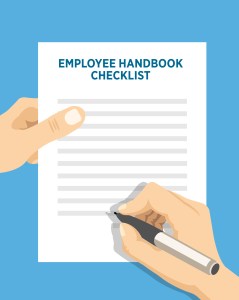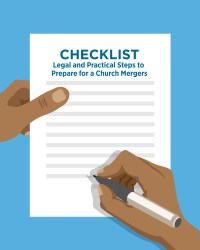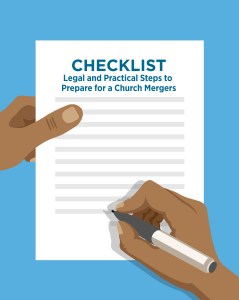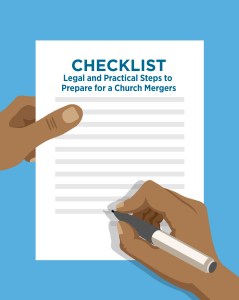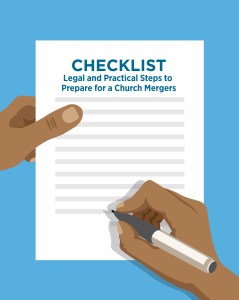Employee handbooks, sometimes called employee manuals or employee policies, often represent the Achilles’ heel of church legal compliance.
Employment lawsuits frequently appear near the top of all types of lawsuits against churches. Employee handbooks may assist in avoiding these lawsuits. And yet, churches often neglect this critical documentation. Or, they copy their handbook from secular sources that neglect the unique nature of churches and other religious organizations.
A handbook is a set of rules, policies, and procedures that govern the relationship between the church and its employees.
A carefully created handbook should include the church’s history, culture, core values, and mission. It should guide the church and its employees’ lives together and address employer and employee expectations arising from the relationship.
This article—the fourth in my series on church employment—will help churches and ministries create and maintain employee handbooks.
Common excuses for not having an employee handbook
In more than 30 years of working with churches, I’ve heard lots of excuses for not having a handbook.
Many small churches believe they are too small to need one. Other churches claim they lack the time, talent, and money to create and maintain a handbook. Some churches believe that a handbook frustrates and hinders the spiritual side of their work environments.
Then there are church leaders who dislike the restrictions that come with using a handbook. Many leaders believe the church is best served by making ad hoc decisions on an employee-by-employee basis, despite the fact that the resulting inconsistent employment decisions inevitably lead to adverse legal and nonlegal consequences.
When closely examining these excuses from church leaders, all of them fail. And that failure likely results in legal liability. While most employment laws require a minimum number of employees, and thus do not apply to many churches, some employment laws apply to churches with just two or more employees. The legal vulnerability is real.
Mishandling employment-related matters may lead to disruption among the ranks of employees. It could also bring charges of unlawful employment actions–even if unintended. That’s why church leaders must make a concerted effort to create a well-drafted handbook.
While doing so requires effort, it will save church leaders time managing their staffs, reducing conflicts and legal liabilities. More important, the handbook can enhance the faith, trust, and community within the church.
While larger churches require professional assistance, the fundamentals of creating and maintaining a handbook are readily available.
Advantages of a handbook
Here are six key advantages to implementing a well-drafted handbook.
Provides organizational structure
In Part 2 of this article series, I discussed the importance of using job descriptions as the set of instructions that give structure for people to accomplish their respective roles in a church. Good structure doesn’t stop there, though. Every organization also needs policies and procedures that guide those leaders and employees.
A church may adopt dozens of individual policies and procedures, so wise church leaders will want those policies and procedures to be coordinated and consistent with each other. The church will also want assurances that it has addressed all the employment-related topics in its policies and procedures. Therefore, it makes sense to address all the employment-related policies and procedures in a single document, with references or hyperlinks to the detailed policies and procedures.
The church must also manage the handbook’s length to avoid making it too long to be useful. If the handbook exceeds 50 pages, many employees will not read it.
Assures compliance with employment laws
Church leaders must adopt policies and procedures to protect the church, to define the relationship between the church and its employees, and to comply with applicable laws. The handbook provides an important tool to accomplish these goals.
The governing body should approve and require continual maintenance of the handbook. The personnel committee, for example, should review the handbook annually to ensure that it complies with currently applicable laws. Governing bodies and personnel committees then must hold church leaders accountable for following and enforcing the policies and procedures referenced in the handbook.
Welcomes new employees to the church
The handbook introduces a new employee to the culture and work environment created by the church.
Nearly everyone experiences anxiety when reporting to a new job. The handbook should make new employees feel welcome. It should also answer most new employee’s questions about practices and benefits.
The handbook should describe the church’s culture and explain the relationship between the employee and the church, including the church’s expectations. The new employee’s compliance with these expectations helps assimilate him or her into the church team and reduces conflict. The handbook helps the new employee more quickly become a productive team member.
Assists with communication
The handbook should help prevent miscommunication between church leaders and church employees.
For example, listing the church’s rules of conduct and the employment benefits it offers provides a basis for a common understanding between church leaders and staff.
Handbooks, however, are of little use if they are not read or understood by employees. Churches want to encourage new employees to ask questions early in the relationship. If an employee does not understand a part of the employee handbook, the church needs to know as soon as possible.
So, churches should require new employees to read the handbook within the first few weeks of employment, and signal they understand it by signing a statement to that effect. When the church later disciplines an employee for violating a provision in the handbook, the typical employee excuse is, “I did not understand.” This signed document refutes that notion and supports the church’s disciplinary action.
Church leaders should refer employees to the handbook for common employment-related questions. While no handbook will answer all questions, it should reduce the time leaders spend responding to employee questions.
Avoids unreasonable employee demands
One crucial benefit of a handbook is to maintain consistency and to avoid situations where an employee might make unreasonable requests based on difficult or emotionally charged circumstances.
Consider, for example, the employee who sought a raise because his son was starting college and the employee had no resources for college. Or consider a pastor who requested his church to continue his compensation for as long as he or his spouse live because he had failed to participate in the church retirement plan.
By addressing these and similar issues in the handbook, the church establishes objective rules and expectations that help protect the church and its decision-makers from the unreasonable demands of employees, including pastors.
Helps protect the church from litigation
Most employment laws authorize employees to sue the employer for violations of those laws. In addition, some churches must comply with dozens of federal, state, and local employment laws and ordinances.
While church leaders rarely have the time to learn about all the employment laws and ordinances that apply to their church, the handbook can include instructions on how the church complies with employment laws and ordinances. If the church follows its handbook, the opportunity for employees to sue the church is reduced.
A handbook is a legal document, although usually not enforceable as a contract (see “Recommended disclaimers” below).
To ensure it is properly constructed and remains current, it should be regularly reviewed by an attorney or human resources (HR) professional, ideally one locally based who specializes in church employment law.
Decide on the tone
The tone of the handbook should reflect the culture of the church.
If the church culture is formal, the handbook should reflect formal language. If the church culture is informal, the handbook should use a conversational style.
Some churches include photos and illustrations to break up page after page of text. Some handbooks are made more engaging by including hypotheticals and examples. Sometimes churches use anecdotes to illustrate the text and make it more understandable.
Tip. If the “why” behind the policy is explained, employees will more readily adhere to the policy.
Most handbooks for churches start with a letter from the pastor that welcomes employees to the church. This letter helps set the tone for the handbook and introduces employees to the church’s culture, mission, and values. In addition, many handbooks include a history of the church, vision statement, mission statement, and core values statement.
What goes into an employee handbook?
Churches should review the following topics to determine whether they apply to them.
Statement of faith
One of the most critical parts of a handbook is the church’s statement of faith. As a religious organization, churches have the freedom to practice their faith in many of their employment decisions. The statement of faith demonstrates to employees and outside authorities alike that these are sincerely held religious beliefs.
The statement of faith should not be a lengthy treatise. Instead, it should reflect the church’s fundamental beliefs, especially as those beliefs relate to the current culture. Typically, the statement of faith is one to two pages long.
I recommend that churches require job applicants to agree to the statement of faith before applying for a job. I do not recommend copying another church’s statement of faith unless the source church is part of the same denomination or faith group. The statement of faith must reflect the local church’s beliefs as practiced by that church.
Code of conduct
The handbook should include a code of conduct that applies to all employees, including pastors.
Violations of the code of conduct should cause a disciplinary action against the employee. Some states allow the church to apply the code of conduct based on the employee’s conduct both at work and away from work.
The code of conduct should reflect the church’s values, along with the actions expected of its employees. The code should be practical and expressed in terms of right and wrong behaviors. This code should include the church’s expectations of honesty and integrity while condemning dishonest and unlawful behaviors. It should reflect the church’s doctrine and practices as applied in the current culture. I suggest supplying Scripture references where applicable.
Recommended disclaimers
The handbook should include the following disclaimers.
First, it should state that all employees serve at the pleasure of the church and that the church follows the employment “at will” doctrine (except in Montana). The employment “at will” doctrine means either the employer or employee can terminate the relationship at any time, with or without a reason, as long as the reason does not violate an employment statute.
Second, the handbook should state that it does not create a contract between the church and the employee. The existence of an employment contract alters or eliminates the employment “at will” doctrine. Without this disclaimer, some courts have ruled that the handbook eliminated the “at will“ doctrine and enforced the handbook as a contract.
Third, it should notify employees that the handbook can be changed at any time without notice, although employees still should be informed of changes in a timely manner.
Finally, it should make it clear that employment is not for any specific length of time.
Topics based on federal statutes
Most churches must adhere to federal employment statutes. The best way to assure compliance with these statutes is to adopt policies and procedures that reflect how the church complies with those statutes. Therefore, the church should consider whether its handbook should address each of the topics arising from the federal employment statutes below as they apply to the church. While I have attempted to list all federal employment statutes applicable to churches, the list may not be comprehensive.
Note. While most churches are subject to federal employment statutes, all states also have employment statutes. Usually they mirror the federal statute and apply to employers that would otherwise be exempt from the federal statute. If a conflict between the statutes arises, the most-employee-favorable statute will apply. Additional information on state statutes is given below in the “Topics based on state and local statutes and ordinances” section.
Churches also should note the applicability (or not) of statutes based on the ministerial exception for ministerial positions.
As explained in Part 1 of this series, the ministerial exception doctrine requires that no federal or state employment statute applies to positions involved in the practice of the religion. The handbook should include an extensive discussion about the ministerial exception and its application to employment laws. For help in understanding and correctly applying the ministerial exception, see Part 1.
Title VII, Civil Rights Act of 1964
This statute applies to churches engaged in interstate commerce with 15 or more employees during 20 or more weeks during a calendar year. In addition, Title VII prohibits employers from refusing to hire, discharge, or otherwise discriminate against any individual about compensation, terms, conditions, or privileges of employment based on race, skin color, religion, gender, ancestry, or national origin.
Note. In June 2020, the Supreme Court expanded the definition of prohibited gender discrimination to include sexual orientation, sexual perception, and gender identity. While the Court’s decision excluded its application to religious employers, the church should be prepared to address its position on these categories with assistance from an attorney.
The church should not fail or refuse to hire, discharge, or discriminate against any individual within any protected class unless a religious exception applies (see “Exception” below). The church cannot limit, segregate, or classify its employees or applicants for employment that would deprive or tend to deprive any individual of employment opportunities or otherwise adversely affect their status because the employee is in a protected class.
This statute applies to all terms of employment, including recruiting, hiring, placement, promotion, termination, layoff, recall, transfer, leaves of absence, compensation, and training.
Exception. As mentioned briefly above, churches may discriminate based on religion for positions involved in the practice of the religion.
If an adverse employment decision involves a mix of religious reasons and other protected class characteristics, the church may still be liable for discriminating against the other protected class or classes.
The handbook should include a statement that the church follows Title VII to the extent it applies to employment positions at the church.
Still, the handbook should not include religion in the list of classes protected by Title VII. Instead, the handbook should state the church bases employment decisions on religion when allowed by law and it reserves all rights available under Title VII.
Americans with Disabilities Act (ADA)
This statute applies to churches engaged in interstate commerce with 15 or more employees.
The church may not discriminate against disabled individuals as defined by the ADA. A person has a disability if he or she has a physical or mental impairment that substantially limits a major life activity.
The ADA also protects individuals who have a record of a substantially limiting impairment and people who are regarded as having a substantially limiting impairment. A substantial impairment significantly limits or restricts a major life activity such as hearing, seeing, speaking, breathing, performing manual tasks, walking, caring for oneself, learning, or working.
The handbook should state that the church complies with the ADA if it has 15 or more employees.
Caution. The church must evaluate applicants for positions based on their ability to perform the job’s core functions, with or without accommodation. Those core functions should be described in the job description.
The church should reasonably accommodate qualified individuals with known disabilities unless, by doing so, the church experiences undue hardship. These concepts should be included in the handbook to ensure they are top of mind for the church’s decision-makers.
Pregnancy Discrimination Act (PDA)
This statute also only applies to churches with 15 or more employees.
The PDA forbids discrimination based on pregnancy with any aspect of employment, including hiring, firing, pay, job assignments, promotions, layoff, training, fringe benefits, such as leave and health insurance, and any other term or condition of employment. In addition, this statute applies even if the individual became pregnant while violating the church’s code of conduct by engaging in sex outside of marriage.
The PDA also prevents discrimination against nursing mothers. The employer must provide a private room, other than a restroom, for expressing milk. It also must provide unpaid breaks to allow nursing mothers time away from their workstations to express their milk for up to one year after giving birth. Some states give nursing mothers additional rights and mandatory accommodations.
The handbook can honor individuals protected by the PDA and state that the church complies with the PDA if it has 15 or more employees.
Harassment
Title VII applies to harassment based on the Title VII protected classes. Harassment is illegal when it is so frequent or severe that it creates a hostile or offensive work environment or when it results in an adverse employment decision (such as the victim being fired or demoted).
Churches must protect employees from harassment by members, vendors, volunteers, and other employees. The handbook should include:
- A definition of harassment. Harassment can include “sexual harassment,” including unwelcome sexual advances, requests for sexual favors, and other verbal or physical harassment of a sexual nature. Many courts have expanded harassment to include bullying.
- The process for reporting the harassment. The church should include multiple places and ways to report harassment. Some female employees are reluctant to report sexual harassment to a male. The available places to report harassment should include at least one female. Also, the church cannot have a subordinate receiving harassment reports against a higher-level employee. If the harassment report is against a church leader, the handbook should include a way to report to a governance board member or the church’s outside law firm.
- The process for investigating the harassment. Remember that subordinates cannot investigate claims of harassment against persons above them in the organizational chart. The church’s HR director frequently investigates claims against nonleadership employees. The investigation should be completed and reported to the complaining employee within ten days after receipt of the claim.
- The penalties for harassment. The handbook should state the penalty can include termination or probation. It should also bar retaliatory actions against those who file a report, but it should allow disciplinary actions against those who file a false report or file one in bad faith.
Occupational Safety and Health Act (OSHA)
Employee safety needs to be addressed in the handbook. Churches must report to OSHA all work-related deaths, in-patient hospitalizations, amputations, and eye losses. If the death occurs within 30 days of the work-related incident, the church must report the death within 8 hours of learning of it.
For any in-patient hospitalization, amputation, or eye loss that occurs within 24 hours of a work-related incident, the church must report the event to OSHA within 24 hours of learning of it.
The handbook should state that the church takes employee safety seriously and complies with the employee safety requirements and OSHA rules that apply to the church.
Note. OSHA does not apply to a church’s religious employees. Also, while much of OSHA’s detailed recordkeeping does not apply to a church, all other provisions may apply to church-operated schools, daycare centers, and other administrative personnel of the church.
Fair Labor Standards Act (FLSA)
FLSA applies to most churches because it covers enterprises that engage in interstate commerce. Thus, even if the church conducts no activities or business outside its home state, the FLSA also applies to individual positions involved in interstate commerce. For example, if an administrative assistant regularly orders office supplies over the internet, the position is likely covered by the FLSA even if the church is not a covered enterprise.
Note. Forty-five states have a similar statute that applies even if the FLSA does not apply. Sometimes the state version of the FLSA is more employee-favorable than the FLSA. If the FLSA does not apply, then the state law equivalent will apply. I recommend that all churches follow the FLSA and state minimum wage and overtime laws because employees expect it, and noncompliance can be costly.
Handbook must-haves
FLSA requires employers to pay minimum wage and overtime to nonexempt workers. Therefore, the handbook should address these issues:
- Worker classifications. A brief description of the different FLSA classifications: ministerial exception, exempt, and nonexempt. Many churches wrongfully classify certain workers as exempt. Churches may have numerous different and self-made definitions of various employee categories. The handbook should be tailored to meet the church’s employment model, but the church should be cautious of creating employee categories that cannot be managed lawfully and efficiently.The US Department of Labor (DOL) provides a safe harbor for the misclassification of exempt and nonexempt employees. If the handbook allows employees to appeal their misclassifications to the church’s senior leaders and those leaders carefully review the classification, then the DOL will usually grant leniency if an employee is ultimately deemed to have been misclassified by the church. (For help classifying employees according to the FLSA, see chapter 5 in Elaine Sommerville’s Church Compensation, Second Edition: From Strategic Plan to Compliance.)
- Church workweek. Federal overtime is based on the employee working over 40 hours during a workweek. The handbook should include the church’s definition of “workweek” for the FLSA. A workweek is 7 days. The church may select any day as the start of the workweek. The handbook should tell nonexempt employees overtime applies when the nonexempt employee works over 40 hours. The payment of paid time off (holidays, vacations, personal days, and sick leave) does not create overtime.
Note: California generally measures overtime based on working more than 8 hours within a 24-hour period instead of the workweek. All other states use the federal workweek definition.
The importance of work time, timekeeping, overtime and time-off
- Definition of work time. The handbook should define when a nonexempt employee is “on the clock.” In today’s 24 hours a day/7 days a week world, the church cannot expect nonexempt employees to be available 24/7 without paying them 24/7, and being on call counts as compensable time. (If the church requires church attendance, the church must pay the employees for church attendance.)
- Timekeeping. Since the FLSA requires nonexempt employees to keep timesheets, the handbook should include instructions on using the church’s timesheet system.
- Authorizing overtime. The handbook should tell employees which managers and executive leaders may authorize overtime. However, the handbook cannot prohibit the church from paying overtime, even if the overtime was not authorized. If an employee repeatedly works unauthorized overtime, the church may discipline the employee for violating the church’s policy requiring advance approval.
- Compensatory time off. The handbook cannot authorize compensatory time off to avoid paying overtime to nonexempt employees. Since a workweek measures overtime payments, the church may not avoid paying overtime by allowing an employee paid time off outside the same workweek as the overtime was worked.
- Volunteer time for the church. The handbook should inform employees that they may not volunteer to serve the church in a similar role as their work role. The DOL believes that nonprofit employers might pressure employees to work without compensation (i.e., in a volunteer capacity) to avoid paying overtime.
Equal Pay Act
The Equal Pay Act, included in the FLSA, applies to every employer subject to the FLSA. It requires that equally situated employees must be paid equally.
The handbook should state that the church complies with this statute, and the church should establish a compensation protocol that honors the Equal Pay Act.
Immigration Laws
Churches are subject to the immigration statutes that require the church only to hire citizens and those authorized to work in the United States.
Churches must secure a Form I-9 (Employment Eligibility Verification) from each new employee. The church must maintain a physical copy of each Form I-9.
The handbook should notify employees that the church follows federal immigration laws, and those employees with day-to-day involvement with authorizations to work should understand the requirements.
Tax Laws
Churches must collect payroll taxes from nonministerial employees. Each employee must provide a Form W-4. The best practice is to require this form annually from employees.
Note. As authorized by the Internal Revenue Code, a few churches have opted out of withholding FICA and Medicare from their employees on religious grounds. Those churches that filed Form 8274 in a timely manner should not withhold FICA and Medicare taxes from their employees. They should tell employees that employees still will owe self-employment taxes on their church compensation.
Ministerial employees may provide a Form W-4, but they must specify the dollar amount they want to be withheld for federal and state income tax purposes. However, the church is prohibited from withholding FICA and Medicare taxes from ministerial employees.
The handbook may contain a general statement of the church’s withholding requirements to appropriately manage employee expectations.
Genetic Information Nondiscrimination Act of 2008 (GINA)
GINA applies to all churches with 15 or more employees. This statute prohibits employers from using genetic information in making employment decisions. The handbook should state the church complies with GINA, and often this compliance initiative is included near or within the policies applicable to Title VII.
Fair Credit Reporting Act (FCRA)
FCRA governs when and if the church may conduct criminal or financial background checks.
The church may conduct background checks only with the applicant or employee’s written consent. The DOL has claimed that background checks have been used to enable unlawful discrimination under Title VII. Therefore, I recommend that churches not conduct the background check until a conditional offer of employment has been made.
The handbook should state which positions, generally, the church may conduct a background check for, when the checks will occur, who will have access to the background check results, how the results will get stored, and when—if ever—the results of the background checks are destroyed. For positions working with children or youth, the background checks should be repeated as often as the church’s insurance carrier requires (typically every three years). For financial positions, the credit report should be repeated every three to five years, or when the church suspects malfeasance.
Family and Medical Leave Act (FMLA)
FMLA applies to churches with 50 or more employees during 20 or more weeks during a calendar year. Like other federal employment statutes, the employee count includes all entities under the church’s control. For example, if the church also operates a school in a separate corporation and the church elects a majority of the school’s board, then the school’s employees are added to the church’s employees to determine whether the FMLA applies.
Except for certain hierarchical churches, denominational bodies do not include local churches in their employee counts because they do not maintain legal control over them.
In addition, the church must offer unpaid leave due to certain medical conditions to qualifying employees.
For situations in which the FMLA applies, the handbook should describe who is qualified for FMLA leave; when it may be taken; how the leave should be coordinated with other types of leave; the documentation required for the leave; the minimum leave time increment available; the availability of fringe benefits during the leave; the notifications required for coming back to work; and the reentry process for when the employee returns to work.
The handbook should also address the different FMLA leave required when the leave involves a military member of the family. The FMLA policy, appropriately crafted, will serve as a tremendous tool for those administering leave that the FMLA covers.
Worker Adjustment and Retraining Notification Act (WARN)
If a church has 100 or more full-time employees, or has 100 or more full-time and part-time employees working 4,000 or more hours per week, WARN requires the church to notify the state employment agency in advance if it plans to lay off or reduce hours for a significant portion of its workforce. The employee count includes all entities under the church’s control.
If applicable, information about WARN should be included in the handbook.
Uniformed Services Employment and Reemployment Rights Act (USERRA)
USERRA requires employers of all sizes to provide a five-year, unpaid leave of absence to individuals called into service with the United States military.
The church must reinstate covered employees to the same or similar position before their military service. The church must compensate and provide benefits as if they had never left employment. Upon returning, they may have the same tenure, compensation, and benefits as those employees who remain continuously employed with the church.
The handbook should include references to USERRA and provide the processes to allow the church to comply with this statute.
Topics from state and local statutes and ordinances
No handbook is complete without addressing state statutes and local ordinances applicable to employment. Also, if a church has employees working in states other than the church’s home state, the church will need to address each state’s statutes and each local government’s ordinances in the handbook. This topic becomes very important for multisite churches that cross state boundaries. Therefore, while I cannot address all the topics and variables among the 50 states, I will list frequent topics addressed in state statutes and local ordinances.
Note. Since this list is not exhaustive, church leaders should familiarize themselves with their state statutes and local ordinances. Any pertinent statutes or ordinances should then be addressed in the handbook. When in doubt, consult a local attorney or HR professional with expertise in state employment law and local ordinances.
Additional classifications protected from discrimination
Many states have adopted a version of Title VII that adds to the federal list of protected classes of individuals. Your church will need to determine whether these additional protected classes apply to them or if an exclusion is available to religious employers. For example, some state laws protect from discrimination because of marital status, sexual orientation, sexual perception, and gender identity.
Payday laws
All states have payday laws, with significant fines and penalties for violations. These laws govern when and how an employer must pay an employee. They apply to all churches and govern various issues, including pay frequency, payment of wages upon separation of service, and withholding authorizations.
While withholding payroll taxes does not require employee authorization, almost every other deduction from an employee’s pay must be voluntary and authorized in writing by the employee.
Employment of minors
Every state regulates the employment of individuals under the age of 18. Therefore, the handbook should either prohibit the employment of individuals under 18 or allow employment authorized by the state statute.
Garnishment
All states allow garnishment of wages by certain classes of creditors with a court or administrative agency order. The handbook should state the church complies with garnishment court orders.
Required time off
Some states require certain types of paid time off, such as paid sick leave; the payment of accrued vacation and sick leave upon separation from employment; and authorized time off to fulfill civic duties, such as jury service and voting—and the time off may be paid or unpaid, depending on state law or the church’s written policy.
The handbook should reflect state law and the church’s business decisions applicable to compensation for required time off.
Mandatory breaks and lunches
Some states require paid and/or unpaid breaks during a workday. All states require an uncompensated lunch or meal break if the employee works a minimum number of consecutive hours.
The handbook should, at a minimum, reflect state law, and the policies may also capture a church philosophy relating to employee health and quality of the employee’s work experience.
State unemployment benefits
Most states do not require that churches participate in the state unemployment benefit plan. However, some churches choose to participate so that former employees will have access to unemployment benefits.
The handbook should inform employees of the church’s decision regarding unemployment. This communication helps establish employee expectations should their employment end with the church.
Further, the policy can serve as additional evidence supporting an exemption if the church must defend against a future claim for unemployment benefits.
Workers’ compensation
Forty-six states require employers to carry workers’ compensation insurance. I recommend that every church purchase workers’ compensation insurance, even if the state does not require it.
The handbook should inform the employees about the church’s decision regarding workers’ compensation insurance and the reporting processes for employee injuries and illnesses.
Topics for policies
The handbook should include, summarize, or reference church policies applicable to employees. The policy topics below may not be required by a statute, but instead, they reflect the church’s management decisions related to their employees. The decision to include, summarize, or exclude a policy should be made in consultation with the church’s lawyer or HR professional. In some cases, those policies may be simply hyperlinked or briefly summarized while letting the employee know where and how to obtain a more detailed copy.
Here are some suggested topics to cover:
Temporary workers
If the church employs workers on a temporary or time-limited basis, this policy should describe their benefits during their employment. Offer letters for a temporary employee then may be tailored to dovetail with the policy to establish employee expectations.
Remote work
The handbook should include the church’s policy on allowing certain employees to work remotely, including the terms and conditions of remote work. A separate “remote work commitment” form may be included so the policy expectations are manageable.
Nepotism and fraternization
The handbook should include the church’s nepotism and fraternization policy. The policy should define how the policy applies to family members.
For example, the nepotism policy might state that it only applies to immediate family members. If the church allows family members to be simultaneously employed by the church, the handbook should detail the hiring and supervision requirements for those family members. For instance, the policy should address whether immediate family members can work in the same department or ministry.
Since romantic relationships frequently occur in the workplace, the church should address this topic. Romantic relations can sometimes develop into unlawful harassment. The policy should also explain the protocol to follow if coworkers become romantically involved so that the risk of harassment is minimized.
Compensation
The handbook should describe the church’s compensation policies, including descriptions of the church’s compensation philosophy, the church’s compensation decision-makers, and its review processes.
Available fringe benefits
This policy should define the available fringe benefits offered by the church and the classes of employees eligible for the benefits. (Often, churches offer fringe benefits to specific groups or “classes” of employees.)
Churches should pay close attention to the different statutory requirements for each fringe benefit. The employee benefit statutes often contain specific definitions that may not fit neatly within the church’s definitions of who should be eligible for benefits.
Caution. An employee benefits attorney should review the church’s classification system to confirm compliance with employment and tax laws.
Policy statements regarding fringe benefits should include a disclaimer that the nature and extent of benefits may change at any time, with or without notice to the employee.
The handbook should express the employer’s discretion to discontinue any benefit. The benefits summary should be a general overview and should allow for flexibility.
Some fringe benefits will reference a separate document or policy. The specific plan documents generally control over the handbook. Often “See HR for details” is an appropriate way to manage expectations and any conflicts between a plan and a policy. The HR department should always have a current list of benefits or plans.
Note. Typical fringe benefits that require separate policies or documents include health benefits, retirement benefits, life insurance, disability benefits, a cafeteria or flex benefit plan, dependent care assistance, educational assistance, tuition discounts, continuing education, mass transit passes, and a legal benefit plan.
The handbook should note that churches are exempt from COBRA continuation rights for health insurance, so that employees become informed about this limitation. However, some states have similar laws that do not exclude churches. Also, some health insurance companies voluntarily offer continuation rights. In any event, the church needs to inform its employees regarding health insurance continuation rights.
Vacation, paid time off, and holidays
A policy should list types of paid time off and other forms of leave. Besides the law-mandated leaves, most churches provide paid holiday pay, vacation, sick leave, bereavement leave, and jury service leave. Due to potential violations of deferred compensation rules, the church should not allow employees to carry unused paid leave to subsequent years.
If the church offers a sabbatical leave, this policy should outline the eligibility and logistical issues. In addition, many churches have a separate sabbatical leave policy that contains more details about this leave.
This policy should describe the circumstances when the church might dock an employee’s pay, such as when the employee reports to work late. In addition, the church should check its docking policy against federal and state laws, such as the FLSA, especially for employees who are classified as exempt from overtime requirements.
The handbook should include a discussion of absenteeism and job abandonment.
Outside employment
This policy should address whether employees may engage in employment outside of the church and any conditions associated with outside employment.
Computer, laptop, tablet, and cellphone
If the church provides computers, laptops, tablets, and/or cellphones to its employees, the policy should describe the terms and conditions associated with appropriate uses or refer to the policy.
Internet usage
Every church requires employees to utilize the internet in performing their job duties. Therefore, this policy should describe the terms and conditions associated with internet usage, even if the employee brings their own device or cellphone to the office.
Social media
Most churches have a social media presence, and most employees also have a personal social media presence. Since social media presents the church to a worldwide audience, everything posted on social media by employees will represent the church. Therefore, the handbook should include the church’s social media policy or reference to it.
Media inquiries
If the church appears in the media, reporters will frequently contact church employees for comments or additional information. This policy prevents unauthorized employees from communicating with any media representatives. The handbook should inform employees about this policy and instruct them to refer the media inquiries to the authorized spokesperson.
Dress code and appearance
Some churches include a dress code in their handbooks. The policy should reflect the church’s culture. For example, the church may want to dictate business attire in a traditional culture, while an informal culture may require business casual attire. In addition, the policy may allow employees to dress appropriately for the job duties.
Some churches base their dress code on sincerely held religious beliefs. If the religious beliefs dictate a different dress code for men than women (or vice versa), the handbook should detail religious reasons for the church’s dress code. For example, some churches require women to wear dresses and skirts because they believe the Bible requires women to wear dresses and skirts.
Caution. If the church has adopted a dress code policy, it must pay close attention to whether the policy unlawfully discriminates against the protected classes covered under Title VII. For example, a policy prohibiting the wearing of shorts or tank tops should apply to both genders.
Workplace safety, violence prevention, and weapons
The church should have a workplace safety policy that includes its safety protocols. The handbook should provide a means for employees to report if they believe an employee, volunteer, or member threatens workplace violence or exhibits a violent temper.
If the church restricts employees from possessing weapons on campus, the handbook should tell the employees the restrictions. Some states’ laws restrict possession of handguns or weapons if the church has a school or daycare on site. The church’s policy should be tailored to comply with any such restrictions.
The church should adopt a security plan to guide employees if an emergency occurs, such as a fire, flood, medical emergency, or unauthorized intruders. The handbook should reference the plan and tell employees how to access it.
Safety
The church should adopt a safe practices policy regarding hazardous chemical usage or power equipment, such as mowers. It will indicate the OSHA requirements applicable to the church. The handbook should alert the employees to the existence of such a policy and how to access it.
Infectious Diseases
Churches should adopt an infectious disease policy that informs employees regarding the requirements to maintain a safe workplace. The policy should prohibit employees from reporting to work sick, or if they have been exposed to an infectious disease. The handbook should summarize and reference the policy.
Child abuse
Churches that maintain children’s or youth programs or daycares should adopt a child abuse reporting policy that addresses state law. Child abuse reporting laws vary from state to state, so any policy should be tailored to meet the applicable legal requirements.
Vehicle operations and cellphone use
The church should address the requirements to operate church vehicles on church business. For example, most vehicle insurance policies require that all drivers be screened for valid licenses and citation history. If the church operates buses, the church should mandate that bus drivers possess a commercial driver’s license.
Employees required to drive a vehicle to conduct church business must understand the hazards and possible legal issues related to using a cellphone while driving. The church might be held liable if the employee uses a cellphone while driving on behalf of the church and causes an accident. Therefore, the church should prohibit cellphone use without a hands-free device while driving on church business, and such a prohibition should be stated in the handbook.
Alcohol and tobacco
If the church restricts employees from using alcohol and/or tobacco, a policy should explain the restrictions.
Drug testing
If the church implements a drug-testing policy that complies with state requirements, the policy should detail when the church may test for illegal substances and the process followed if the presence of drugs is detected.
Intellectual property
Every church needs an intellectual property policy that informs employees about the work for hire doctrine. It should explain how the church applies this doctrine to intellectual property created by employees within the scope of their duties and responsibilities and/or through use of the church’s assets.
Business expense reimbursements and church-issued credit cards
If the church reimburses employees for business expenses incurred by the employee, the handbook should include the policy or refer to the policy. This policy should address any conference and training requirements imposed by the church. It should also convey any restrictions on reimbursements of certain expenses. For example, many churches refuse to reimburse the cost of alcoholic beverages.
If the church provides a church-issued credit card to employees, the handbook should include the credit card policy or a reference to the policy. In addition, the handbook should include whether the church requires employees to enter into a credit card agreement to be issued a credit card.
Whistleblower
Every church must adopt a whistleblower policy to comply with federal law. The handbook should summarize and reference the policy.
Conflict of Interest
The IRS requires every church to adopt and follow a conflict-of-interest policy. The handbook should summarize and reference the policy as applicable to employees.
Confidentiality and privacy
The church handles many confidential matters. The handbook should tell employees how the church defines and handles confidential matters.
The Health Insurance Portability and Accountability Act (HIPAA) applies to some churches, meaning the church must treat all medical information confidentially in accordance with the law.
The church also needs to enact safeguards to keep financial and personal data private.
Note. Financial-related and personal information may also constitute a trade secret, creating a mechanism for pursuing employees who steal such information.
Many employees have a level of expectation of privacy while working. The handbook should describe the church’s privacy policies. It should explain how and when the church may use employees’ private information.
A policy should also inform employees about the church’s surveillance tools. Such tools including screening emails, surveillance cameras, and scanning employee computers and laptops.
Access to employee files
This policy should detail the files the church maintains on each employee. It should also detail the contents of each file and whether an employee has access to that file. The policy should follow state laws regarding this topic.
Employee Discipline
Not every employee performs at the level the church expects. The church has much latitude in implementing a discipline policy. But it should seek to address employee shortcomings fairly and provide a mechanism for employees to initiate reports of unfair treatment by other church employees.
The discipline section should describe the process implemented when an employee fails to meet the church’s expectations. Many churches use a progressive disciplinary system. Under this sytem, the employee first receives a verbal warning. The next step is a written warning followed by a performance improvement plan. The last step is termination should the employee continue to fail to meet the church’s expectations.
The handbook should state that employees may not require the church to follow its disciplinary system in all circumstances. It should allow for immediate termination if the church determines that action best serves the church.
Separations from employment
Separations are either voluntary or involuntary.
The policy should state that employees are required to give notice before voluntarily leaving employment.
Involuntary separations include layoffs and employer-initiated separations from employment. A policy may describe how the church will implement a layoff if the need for one arises.
This section should include the church’s policy on separation payments, if any. Most former church employees cannot claim unemployment benefits. Therefore, many churches provide for generous separation payments. If the church provides a generous separation payment, the church should consider securing a separation agreement with a release.
This section also should include the exit interview process and discuss the process for rehiring if the employee and church desire.
Retirement
While a church cannot utilize a mandatory retirement age for employees not covered by the ministerial exception, the handbook should describe the process for employees who want to retire. The handbook may describe when the church may require ministerial exception employees to retire.
References
The church should include its policy regarding references provided to former employees. Some states provide immunity to former employers who provide negative references if former employees consent in writing to the reference beforehand. In addition, some churches adopt a policy of providing only the dates of employment, job titles, and final compensation.
Alternate dispute resolution
Should your church have an alternative dispute resolution policy and agreement and, thus, include it in your handbook?
Many churches prefer to use biblically based alternative dispute resolution to resolve disagreements with employees. The main benefit is that disputes are handled privately and outside of a public forum.
Biblically based alternative dispute resolution services will appoint a neutral mediator to see if the dispute can be resolved by an agreement instead of arbitration or a lawsuit. The neutral mediator will utilize biblical principles and legal principles to assist the parties in settling their dispute. Good mediators typically will have an 80-percent success rate.
The most significant disadvantage of mediation or private arbitration is cost. The mediator or arbitrator will require payment for his or her services, while the government pays a judge. If not resolved in mediation, an arbitrator or arbitrators will cost several thousand dollars a day to conduct the arbitration.
My experience is that an arbitration costs slightly less than regular lawsuits. Still, arbitrator fees, experience, and efficiencies can tilt the expense scale otherwise, depending on the dispute in arbitration.
Suppose the church wants to implement a biblically based alternative dispute resolution policy. It should describe the process in the handbook. It should also require all employees to agree to abide by the policy in writing.
Caution. Some states restrict the use of alternative dispute resolution for employee disputes. The church should check its state law on the topic before implementing it. Also, because the handbook is not necessarily a contract, and because the policies may be amended without notice to an employee, a policy that seeks to require biblically based alternative dispute resolution may be unenforceable under law.
Due care with the guidance of a qualified attorney should be taken to create an enforceable agreement if biblically based alternate dispute resolution is the church’s choice. Additionally, churches should check with their insurers about coverage. Some insurance companies will not pay the cost of biblically based alternative dispute resolution, while they will pay for defending a lawsuit if the church has employment practices liability insurance.
Implementing an employee handbook
All churches with over two employees should adopt a comprehensive handbook. Smaller churches may adopt a shorter handbook given certain employment matters do not apply to them.
But larger churches (more than 15 employees) need a more comprehensive handbook given a wider array of regulations. Whether a small church or large church, implementation represents a significant undertaking.
Tip. By using this PDF checklist, you’ll have a systematic process for tackling this expansive project and covering everything that needs to be included in your handbook.
Suggested steps for developing and reviewing a handbook
Here are suggested steps for developing a handbook and then conducting periodic reviews of it:
- The church’s governing body should formally decide the church needs a handbook, and along with its creation, also direct subsequent periodic reviews. Frequently, the governing body will delegate the drafting and updating to a personnel committee, assisted by the church’s HR director, other staff, and the church’s attorney.
- The personnel committee will decide what will go in the handbook and utilize the accompanying checklist to help move through the process of developing the handbook or reviewing a current one. The committee will frequently enlist volunteer HR professionals from the church or engage an outside law firm to draft and update the handbook.
- Once the personnel committee approves the draft, the church’s attorney should review it for compliance with employment laws applicable to the church.
- The senior leadership should then review, comment, and suggest changes to the draft. Afterward, the senior leadership should recommend the handbook and all updates to the governing body for approval. After senior leadership’s approval, the governing body should adopt the handbook and require distributing it to all employees.
- Every one to two years, the personnel committee should review the handbook with assistance from church staff, an HR professional, and an attorney.
- Any changes should be drafted and approved by the personnel committee and the church’s attorney before presenting them to the senior leadership or governing body.
- Once approved by the governing body, the revised handbook should be distributed to all employees. Publishing a handbook has become simpler with the internet. Most churches publish the handbook on the church’s website behind an employee login.
Caution. I do not recommend publishing it on the church’s website without the login because the handbook represents a trade secret under many state laws. This login requirement means that the church may protect its contents from misuse. Also, the handbook should be marked as protected by copyright. This copyright protection means that others cannot copy and use it without the church’s permission.
Confirm employee understanding and agreement
- After approval by the governing body, senior church leaders need to confirm that all employees have read, understood, and agreed with the handbook. Most churches require all new employees to sign an agreement within a few weeks of employment. The agreement reflects that the employee has read, understood, and agreed with the handbook. The employee agreement should be renewed with each subsequent revision.
Stewarding your most valuable earthly asset
Developing an employee handbook may seem like a daunting task. But doing so will help your church show good stewardship over its most valuable earthly asset–its employees.
My hope and prayer is that the guidance and accompanying checklist will help streamline the process. It will also help create a legally-compliant handbook that serves your church and its employees well.
The author thanks CPA Elaine Sommerville for her useful comments and edits to this article.
Return to series home page.

